ROCK MUSIC IN JAPAN IN THE 1960S
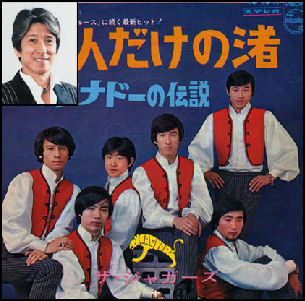
The Jaguars In 1960s Japan, the Ventures ignited the guiyra-driven Eleki craze and The Beatles gave birth to the Group Sound of bands like the Tigers, the Blue Comets and the Spiders. The only Japanese song to reach number one in the United States was the 1964 hit Sukiyaki by Kyu Sakamoto.
Setting a pattern for the import of each new Western pop music genre, the rock-and-roll boom sparked by Elvis Presley in the mid-1950s spawned a large number of home-grown rock-and-roll bands. The 1960s saw the development of both a Bob Dylan-influenced folk music movement and the “group sounds” movement spurred by the Beatles. Subsequently, pop music genres such as psychedelic rock, country rock, heavy metal, punk, reggae, funk, rap, techno and hip-hop developed their own followings and their own groups of Japanese performers. [
“ Japanrocksampler: How Post-War Japanese Blew Their Minds on Rock “N’Roll” is a book by Julian Cope, who first made a name for himself in the British group Teardrop Explodes. Among the groups highlighted in the book — most of which most Japanese have never heard or can’t recall — are Flower Traveling Band, Murahatchibu, Foodbrain, the Far East Family Band, Magical Power Mako and Les Rallizes Denudes. The later had a strong cult following and were active from 1967 to 1970, when their bass player was involved in a Japan Airlines hijacking and defected to North Korea.
The Japanese female singer Yuming marked her 40th year as a performer by performing and touring with Procom Harum. Another Japanese female singer Superfly sang some of Janis Joplin’s at an event at Woodstock with Joplin’s band Big Brother and the Holding Company.
Good Websites and Sources: Rock of Japan rockofjapan.com ; X Japan Official site xjapan.co.uk ; Hide Official site (Japanese Langauge) hide-city.com ; B’z Official Site ; Glay Official Site glay.co.jp ;Puffy puffyamiyumi.com ; Wikipedia article on Puffy Ami Yumi Wikipedia
Links in this Website: CLASSICAL JAPANESE MUSIC Factsanddetails.com/Japan ; WESTERN CLASSICAL MUSIC IN JAPAN Factsanddetails.com/Japan ; JAPANESE FOLK MUSIC AND ENKA Factsanddetails.com/Japan ; J-POP AND POP MUSIC IN JAPAN Factsanddetails.com/Japan ; J-POP AND POP ARTISTS IN JAPAN Factsanddetails.com/Japan ; ROCK IN JAPAN Factsanddetails.com/Japan ; PUNK, FOREIGN MUSIC, HIP-HOP IN JAPAN Factsanddetails.com/Japan ; YOKO ONO Factsanddetails.com/Japan ; KARAOKE IN JAPAN Factsanddetails.com/Japan ; DANCE IN JAPAN Factsanddetails.com/Japan
Good Websites and Sources on Japanese Music: “The Rough Guide to the Music of Japan” is a CD assembled by Paul Fisher, Short Introduction to Japanese Music asnic.utexas.edu ; Bibliography on Music in Japan aboutjapan.japansociety.org ;Traditional Japanese Music and Dance sfusd.k12.ca.us/schwww ; Wikipedia article on Music of Japan Wikipedia ; Performing Arts Network of Japan performingarts.jp ; Traditional Performing Arts in Japan kanzaki.com ; Hear Music, a World Music Store with a hearjapan.com ; Japanese, Chinese and Korean CDs and DVDs at Yes Asia yesasia.com ; Japanese, Chinese and Korean CDs and DVDs at Zoom Movie zoommovie.com
Rock Music in Japan in the 1970s and 80s
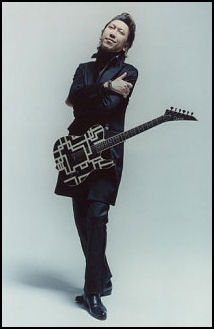
Hotei from the popular
80s group Boowy In the 1970s, David Bowie was very big. He inspired a generation of glam rockers, with outrageous costumes and lots of make-up, who still command a large audience today.
In the 1970s and 1980s, Japanese groups with an international following include the techno-pop group Yellow Magic Orchestra (lead by the World Music "cultural half breed" Haruomi Hosono), the novelty duo Pink Lady and the new wave group the Plastics.
Kioshiro Imawano is rock singer known for his raw vocal style and make up that had a long career in Japan. He first appeared in 1970 with a band called RC Succession and had hits with songs like “ Ameagari no Yozora ni” (“To the Night Sky After the Rain”) and was still going strng with a cult following and son used in commercial in the late 200s. He died in 2009 at the age of 58 of throat cancer.
Former idol Sekio Matsuda has had more than 25 number one singles in Japan. Sometimes refereed to as "Japan's Madonna," she traded in her goody-two-shoe idol persona in the mid-1990s for pink hair and leather and had a hit with the song “Missing You” but was also dogged by rumors and a kiss-and-tell book that alleged she had numerous affairs with her back up singers, one of whom, an American named Christopher Conte, sued for $366,000 for sexual harassment. Matsuda failed in her attempt to break into the United States charts in 1990.
“Yazawa Eikichi, Yuming, Southern All Stars, Chage and Aska, and B’z are some of the musicians whose popularity has endured over a few decades. Yellow Magic Orchestra, a 3-man techno-pop band who made their debut in the late 1970s, were well-known inside and outside Japan for their songs using computers and synthesizers.
Beatles and Beatles Copy Cats in Japan
The Beatles caused as much pandemonium when they arrived in Japan in 1966 as they did when they triggered Beatlemania in the United States in 1964. The Beatles flew into Tokyo on June 29, 1966 and stepped off the plane wearing Japan Airlines hakatas. There were in Japan a total of 102 hours. The toured for three days and were guaranteed a fee of 60 million yen. About 8,400 policemen were mobilized for security. Total cost of mobilization: 90 million yen. Boys and girls taken into police custody: more than 6,500. Paul McCartney of the Beatles was arrested and spent 10 days in jail in Japan in January 1980 after he was caught trying to bring 225 grams of marijuana into Japan.
Japanese are nuts about the Beatles. School children learn passages from “Eleanor Rigby” in school and popular artist perform entire concerts of Beatles songs. There are scores of Beatles tribute clubs with names like Ya! Ya! Ya! and Sgt. Peppers. Almost every major city has at least a handful of them. In Roppongi in Tokyo you can find the Abbey Road live house and Cavern Club as well as specialty shops Get Back and Rubber Soul.
One of the most highly-regarded Beatle copy cat groups called the Parrots. It is made up of Mamoru Yoshii (John), Akio Kurosawa (Paul), Akira Kaneko (George) and Teruyuki Matzurzaki (Ringo). They have mop top hair cuts and can play 123 Beatles songs. In an average week they play five sets a night, five days a week, doing little known songs like “Mr. Moonlight” with same enthusiasm as “Hey Jude” and “She Love's You”. In 1997, they were the headline act at the Liverpool Beatles Convention that was jammed and included the likes of Oasis's Noel Gallagher.
One of the Parrots biggest fans, Rumi Kaneko, likes them more than the Beatles. She sees them at least three times a week and edits a fanzine called The Parrots Time.
Yoko Ono
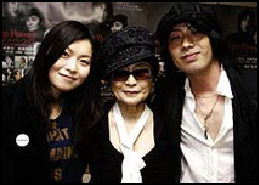
Yoko Ono with the Japanese
group Love Psychedelico Yoko Ono is arguably the most famous Japanese person in the world, past or present, and has been so for a long time. Certainly more people outside Japan know her than the current leader of Japan. Her closest rivals for fame, in the United States anyway, the Japanese baseball players Ichiro Suzuki and Hideki Matsui.
Ono also has always regarded herself an artist and certainly sees herself as more than the widow of John Lennon although she has taken it upon herself met to maintain his legacy and image. Lennon met Ono at a London exhibition of her art and later called her "the world's most famous unknown artist. Everybody knows her name, but nobody knows what she does."
To many Ono is a villain. Summing up the way she is perceived the feminist writer Germaine Greer said in the mid 2000s that Ono “is still hated and reviled....Her enormous wealth can be no consolation for the knee jerk assumption she encounters a hundred times a day that she destroyed Lennon’s gift and broke up the best band there ever was.”
Ono turned 87 in 2020. For a long time she returned to Japan at least once a year. Many years she did charity shows with Japanese artists.
See Separate Article YOKO ONO: HER LIFE, ART AND MUSIC, THE BEATLES' BREAK UP AND JOHN LENNON'S DEATH factsanddetails.com
X Japan

X Japan at Madison Square Garden X Japan was arguably the biggest rock group in Japan in the 1990s. They were a loud, thrashing band that regularly sold-out 50,000-seat arenas and sold more records than any other independent label band ever. The group also has a surprisingly large following in France.
X Japan pioneered the popular glam-rock movement in Japan and are regarded as the founders of Visual-kei, Japanese glam rock. They wore outrageous costumes and lots of make-up, championing the over-the-top androgenous look. Yoshiki was the drummer, keyboardist and driving force behind the group but not its most popular member.
In 1992 X-Japan became the first Japanese ban to sell out the Tokyo Dome, the same year they signed a worldwide deal with Atlantic Records that never produced any records. Among their hits were the trancelike “Art of Life”, the ballad “Endless Rain”. X-Japan broke up in 1997
Hide
Hide (pronounced Hee-Day) was the guitarist in X Japan. Known for his bright pink pompadour-mohawk and thick layers of eye make-up, he was a excellent guitarist and was the heart and soul of X Japan in the same way the Keith Richards is the heart and soul of the Rolling Stones.
Hide's real name was named Hideto Matsumoto. During his musical career he worked with Beatles producer George Martin and groups like Nine Inch Nails and Killing Joke.
On May 2, 1998, a few months X Japan broke up, Hide was found dead in his Tokyo apartment with one end a towel tied around his neck and the other looped around the doorknob to his bathroom. Whether it was suicide or an accident is an issue that is still no t resolved,
After the suicide, Hide's singles “Pink Spider” and “Rocket Drive” zoomed to the top of the charts and five teen-age girls tried to commit suicide (three of whom were successful, including one who leapt from a bridge and another who hung herself). Over 50,000 people showed up for his funeral, where 200 people were treated at a medical tent and 60 were hospitalized, including one girl who tied to slit her wrists with a plastic knife.
In 2008, the four surviving members of X-Japan did four shows at the Tokyo Dome. Hide was present on a huge screen behind the group and in a cylindrical holographic device at center stage, Also joining the group were Luna Sea guitarist Sugizo, Wes Borland of Limp Bizkit, and Richard Fortis of Guns n’Roses.
S.K.I.N. is a Japanese supergroup composed of J-po sing Gackt, X-Japan cofounder Yoshiki, Luna Sea guitarist Sugizo and Visual kei star Miyavi.
Visual-kei and Japanese Glam-Rock Groups
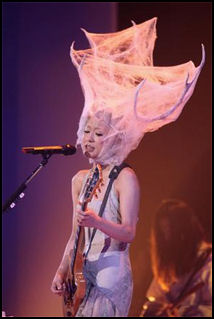
Glam rock was popularized in Britain in the 1970s by artists like David Bowie and Gary Glitter and was characterized by performers with platform shoes, layers of make up, and outrageous hair and glittery costumes. The movement in Japan was pioneered in the 1980s by groups like X-Japan and Boowy and has never gone out of style. Many of the country's most popular J-pop artists — Glay, L'Arc-en-Ciel and Luna Sea (get it, Lunacy) — qualify as glam-rock groups.
In Japan, visual-kei refers to the fashion, look and music of Japanese glam rock. A glam rock group called Versailles was described by critic Steve McClure as “rococo decadence” that “seems inspired by in equal parts by the Marquis de Sade and Liberace. The 1980s saw a boom in so-called “” visualkei”" bands typified by the band X-Japan. These were bands who played mainly heavy rock and metal, with an emphasis on the visual aspect of their performances, featuring dramatic make-up such as white skin with dark eye liner, blue lips, radical hairstyles: pop extreme red, blue or purple, or dressing in what looks like medieval women’s clothing. These unique visuals were copied all over the world and this became one of Japan's most influential music genres.
Visual-kei has been described as “glam rock with a touch of Harlequin romance, Takarazuka all-female review and heavy dose of amphetamines. Members of the groups wear lots of eye-liner and make up, sport puffy, shaggy, streaky effeminate hairdos and wear over the top costumes such as taffeta and silk suits.
Versailles is a visual-kei groups that goes for the Louis XIV gothic look and sells rose-shaped flashlights at their concerts. The guitarist Hizaku told the Yomiuri Shimbun, “Three words that could describe the band are beauty, aggression and pride...Roses are very beautiful, but some people can’t admit that some things are beautiful for just the sale of beauty. I want people to be honest and admit that beautiful things are beautiful.”
Gackt is a popular Japanese glam rocker. He appears from time to time is samurai dramas and has his own video game in which he is the central character. Izam, a Boy-George-like androgenous singer, has made loads of money endorsing everything from canned beverages to moth repellents.
Glay and B'z
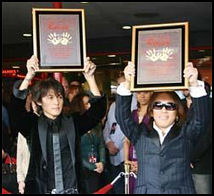
B's enter Walk of Fame
in Hollywood B’z is comprised of vocalist Koshi Inaba and guitarist Takahiro Matsumoto. The duo debuted in 1988 and had sold more than 44 million records as of early 2011. The B’z released their first recording in 1988. As of 2007 the had sold more than 75 million albums in Japan alone. In 2007 they became the first Asian group to be inducted into the Hollywood Rockwalk of fame. Guitarist Takahiro “Tak” Matsumoto and vocalist Koshi Inaba placed their hand prints in cement which are displayed.
In 2011, B’z guitarist Takahiro Matsumoto won the Grammy for Best Pop Instrumental Album with the recording “ Take Your Pick “ made with jazz guitarist Larry Carlton. Japanese jazz pianist Hiromi Uehara also won a grammy for Best Contemporary Jazz Album as a member of the Stanley Clarke Band.
The B'z bestselling albums Pleasure and Treasure sold over 10 million copies in 1998. In 1999 the group drew 650,000 people to concerts in seven cities and won some international music awards. In 2000, the group's management got in trouble for not paying tax on over $7 million in earnings.
Glay is a glam J-pop group from Hokkaido. The four members — Teru, Takuro, Hisashi and Jiro — are each more recognizable for their lacquered hairstyles than their faces and the group's name is a famous misspelling of the shade between black and white. In their first gig Glay attracted an audience of two. Since then they have gone on to sell millions of record and play stadiums and have became so popular their likenesses have been placed on the fuselages of some JAL jets.
Japanese Pop Groups American Critics Have Liked

Shonen Knife Groups the critics like it include the Boredoms (a hardcore punk group that produced mostly unlistenable music but put out a good album in 2001 called “visioncreationnews”), Pizzicato Five (a group that sound like Manhattan Transfer and produced a good album in 1987 called “Couples”), Boris, Acid Mother Temple Buffalo Daughter, Hanatarash, Cornelius (a promising Tokyo-based singer who took his stage name from a character in the “Planet of the Apes”).
Buffalo Daughter is a three person experimental techno new wave group led by singer-guitarist Sugar, who also is the singer-guitarist in heavy metal called Metalchicks. Formed in 1993, Buffalo Daughter was largely unnoticed until the released a record on label run by the Beastie Boys. They have been active since then and traditionally have had a bigger following oversees than in Japan. Sometimes Sugar tours with both Metalchicks and Buffalo daughter at the same time with the former opening for the latter,
Love Psychelico is duo consisted if female singer, Kumi, and a male guitarist, Naoki Sato. They met in a university club and have played the club scene in the United States. The produce likeable, guitar-strumming, Western-style rock-pop that is not psychedelic. The first album, audaciously titled “The Greatest Hit”, sold over 1 million copies. Kumi often sings in English. She lived in San Francisco from age two to seven,
Shonen Knife is more popular outside of Japan than in it and famous for food songs like “Cookie Day” and “Banana Chip”. Named after a brand of pencil-sharpening knives, The group is comprised of two Osaka -born sisters Atsuko and Naoko Yamono and Michie Nakatani. Their sound has been described as “sweet pop-punk.” Kurt Cobain was a big fan. He was reportedly moved to tears after seeing them live. Their albums from the early 1990s, “Let’s Knife” and “Rock Animals”, are regarded as their best.
Shang Shang Typhoon is pop group made up of three men and three women, known for their outlandish costumes and desire to create a festival atmosphere every time they perform.
Puffy
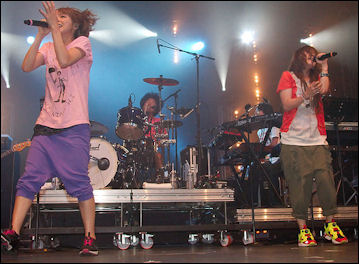
Puffy AmiYumi at Japan Expo Puffy is an unpretentious female duo — Osaka-born Yumi Yoshimura and Tokyo-born Ami Onuki — that produces catchy, pop songs and have sold over 16 million record in Japan. They have toured the United States, where they are known as Puffy AmiYumi to avoid confusion with Puffy Combs, and have opened for the B-52s and have an animated show — “Hi Hi Puffy AmiYumi” — on the cartoon network.
Puffy have hosted their own weekly show in Japan and have had Harrison Ford and Aerosmith as guests and have appeared in commercial for motorscooters, cars, cosmetics, cell phones and soft drinks. Yumi is married to Teru, the lead singer in Glay. Their name was picked by their producer, Andy Sturmer, as he flipped through a dictionary. Sturmer was the leader of 1980s U.S. group called Jellyfish.
Ami and Yumi appear to get along famously well but they didn’t know each before the group was formed. They were united by pop guru Tamio Okuda after performing in separate auditions. They don’t write any songs or lyrics and don’t play any instruments except a small harmonica. Okuda writes many of their songs. Sturmer is said to be responsible for the Puffy sound.
In the United States, Puffy have played in packed clubs in New York and were chosen as goodwill ambassadors for a “Visit Japan” tourism campaign. Their clothing styles and fashions are often imitated by fans. Puffy shows in the United States are virtually identical to those in Japan. Yumi said she doesn’t think not understanding the lyrics is a problem,. She said “I think they just love our tunes and our rhythms.
Ami told Kyodo: said, “I enjoy my work every day, I’m sure we’re very, very lucky. We just did our style of music with our beliefs.” On her fashions she said, “I don’t really have a strong policy about my style...I want to do everything and I want to try everything — that’s it.”
Puffy was the first Japanese pop Group to perform in Macy’s parade in New York. Their performance in front of Macy’s department store was broadcast nationally. “Hi Hi Puffy Ami Yumi” is popular with American children.
Other Japanese Rock and Pop Groups
The Japanese-American band Cibo Matto is lead by keyboard player Yuka Honda, a girlfriend of Sean Lennon.
Superfly is a female singer who dresses in 60s-era floppy hats and bell bottoms and sings great 60s-style songs with her strong soulful voice, She had several hits in Japan in 2008, when she recorded a song with the Australian band Jet, and in 2009, when she performed two Janis Joplin songs with Joplin’s band Big Brother and the Holding Company at the Heros of Woodstock concert in Bethel, New York. Her debut album, featuring a mix of hard driving rockers and melodic pop tunes, sold over a half million copies. Her real name is Shiho Ochi.
Japanese artists with strange names include Bump of Chicken, Scoop on Somebody, Do As Infinity, Mr. Children, Rip Slyme, Bonnie Pink, Ego-Wrappin.
Crystal Kay is a popular Japanese artits who has a Korean mother and African-American father.
Among the Japanese musicians that found success outside of Japan are saxophonist Sadao Watanabe, pianist Makoto Ozone, New Age keyboardist Kitaro Sakamoto Ryuchi (a former member of the Yellow Magic Orchestra) and programmer and producer Makoto Yashiki.
Japanese Guitar Prodigy
Yuto Miyazawa, a 10-year-old Japanese guitar prodigy, was listed by the Guinness Book of World Records as the youngest professional guitarist. Describing a performance at the Hong Kong Fringe Club, Joyce Hor-chung Lau, wrote in the New York Times, “Yuto teased the crowd by announcing his last song, Lynyrd Skynyrd’s “ Free Bird,” and ended it with a flashy solo. With the audience pounding and protesting for more, he gave a heckling fan Ozzy Osbourne’s “ Crazy Train,” then continued the encore with “ The Star Spangled Banner,” a la Jimi Hendrix. The clock had ticked past midnight by the time he got to “ Paranoid,” another Ozzy song from the Black Sabbath days.Then Yuto’s manager, Steve Bernstein, edged toward the stage. It was past the kid’s bedtime.” [Source: Joyce Hor-chung Lau, New York Times, October 20, 2010]
Yuto mainly plays heavy metal favorites. In 2009 he performed at Lollapalooza in Chicago after coming to international notice for a televised performance of “ Crazy Train” on the Ellen DeGeneres show. In an interview with the New York Times, Yuto said that his most memorable performance was when he joined Osbourne this summer onstage in Connecticut for Ozzfest. “Ozzy lifted me up and I felt just like Randy Rhoads,” he said, referring to the late American heavy metal guitarist who played both with Mr. Osbourne and the band Quiet Riot. Yuto’s collection of about 10 guitars includes the Rhoads edition polka-dot Gibson Flying V, which he played in Hong Kong.)
There is no doubting Yuto’s technical skill,” Lau wrote. “And, unlike some young performers pushed into the spotlight, there is nothing mechanical or forced about him. He improvises with glee and slides into riffs with ease. He is in charge on stage, fiddling with his equipment and engaging with band members for a good, tight set. Yuto also sings but, for now, his vocals are no match for his instrumental skills. His voice is still that of a child, and he sometimes sounds like a choir boy who accidentally stumbled into a metal concert. But nobody comes to his shows just to hear him sing.
“Yuto leads a relatively normal life in Tokyo. His father, Tsuneo Miyazawa, works at a bank. His mother is a housewife who cares for him and a younger brother. Some prodigies are surrounded by staff and private tutors, but not Yuto. He goes to school and generally only tours during the holidays. “It’s like he’s 30 when he plays, and 10 when he’s not,” Mr. Bernstein, his manager, said. His father often accompanies Yuto on his travels but remains in the background and could be mistaken for a particularly clean-cut roadie.”
Yuto was a toddler — 1 year and 10 months old, according his father — when he first touched a guitar. He was hooked. He would pick up a vegetable grater, cradle it and try strumming it. His grandfather made him a toy guitar from cardboard and rubber bands. His parents bought him a ukulele. Just before his fourth birthday, he started guitar lessons. Yuto became known in Japan when he was 5 and his parents sent a video to a local television show. “My dad used to be better than me at guitar,” Yuto said. “But now he’s given up.”
“Yuto wants go to tour England. “There is where Ozzy is from,” he said. “Also Ritchie Blackmore, Jimmy Page and Eric Clapton.” For the time being, Yuto’s fame is based on his novelty: The cute Asian boy who excels at a dark, morbid genre. His videos on YouTube get hundreds of thousands of hits. But he wants to be more than merely the kid who can cover Ozzy Osbourne, and has started writing his own material. Yuto ended his Fringe Club show a confident, noisy rocker. Then, as soon as the music stopped, he was back to being a kid. He stood patiently on the small stage and posed for photos. He shook hands with his fans, bowing slightly at the waist.”
Foreign Rock and Pop Groups in Japan
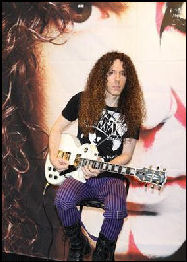
Japanese-speaking
Megadeath guitarist Big name foreign groups and underground artists regularly make stops in Japan, usually just in Tokyo and Osaka. One standard for success in the pop world was making it “big in Japan.” There was even a British group called “Big in Japan.”
Japanese culture has found is way into works by popular American artists. Missy Eliot has employed the Japanese language and images in videos. Linkin Park has incopertated cyberpunkish Japanese animation in theirs. Gwen Stefani dances backed by the Japanese Harajuku dancers,
Taka Hirose has been the bassist in the British Indie band Feeder for more than 20 years. A native of Japan, he helped form the group after moving to London to study and placing an ad in a local newspaper that was answered by a couple of Welshmen’singer/guitarist Grant Nichols and drummer Jon Lee, The group released their debut album “ Echo Park “ in 2002 and has managed to stay together despite the suicide of Lee.
Japan has its own Japanese-language MTV. It was launched in 2001 and boast its own awards ceremony in which Japanese artists compete head to head with American and British artists and win.
Madonna and Coldplay were the best-selling foreign artists on Japan in 2008. Among the foreign artist that performed at the MTV Video Music Awards in 2009 where Black Eyed Peas, Green Day, Kate Perry, (mm Parabellum Bullet. The Beastie By showed up but didn’t perform and were awarded the Street Icon Award.
Michael Jackson, Britney Spears and Queen in Japan
Among the British and American groups that made a big impact on Japan are The Beatles, the Ventures, David Bowie, Kiss, Queen and Cheap Trick.
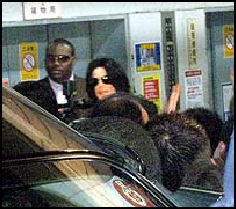
Michael Jackson came to Japan at the height of his fame in 1987. More than 430.000 people came to see him in 14 concerts in place like Tokyo’s Korakuen stadium and Nishinomita stadium in Hyogo Prefecture. At the time it was th highest attendance ever recorded fro a Japanese concert series. Jackson brought his chimpanzee Bubbles with him and rented out Korakuen amusement park for his own use. He also performed in Japan in 1988, 1992, 1993 and 1996.
In December 2006, Michael Jackson offered 200 fans the chance to meet him and have their photograph taken with him for $4,000. He appeared at a concert feature gospel singers and a string section but did not sing or dance. That that people paid $500.
Britney Spears became the center of attention in 2006 when a proposal by to put up poster with her nude and pregnant image in Tokyo subway stations was rejected because the picture was deemed to be too racy. The posters were advertisement for Harper’s Bazaar magazine. Authorities later gave in and allowed to posters to be put up.
Queen remains very popular in Japan. A greatest hits collection called “Jewels”, issued only in Japan, sold 1.8 million copies in 2004.
Lady Gaga in Japan
In December 2011, according to the Hollywood Reporter, Lady Gaga appeared on Japanese national broadcaster NHK's four-hour plus year-end music extravaganza special called Kohaku Uta Gassen, or the Red and White Singing Contest. The show is considered one of the leading musical platforms in the country. There is usually one international artist selected to perform every year. [Source:Hollywood Reporters, December 23, 2011]
Lady Gaga came to Japan for an appearance on the leading weekly music show Music Station. In face-to-face meetings NHK was able to convince the quirky superstar to appear on Kohaku though she returned to the US by the time it was broadcast. The performance took place mid-morning New York time to coincide with the broadcast time in Japan.
Lady Gaga has been a strong supporter of Japan since the triple disasters in March of earthquake, tsunami and nuclear accident. She was one of the few stars that did not cancel her live concerts in the country in the months after the nuclear crisis. Gaga also issued "We Pray for Japan" bracelets with all the money going to disaster victims. Lady Gaga was quoted by NHK as saying that she was honored to be chosen to perform on Kohaku. She noted she would prepare a musical stage show instead of a simple live performance.
In May 2012, the Yomiuri Shimbun reported: “A teacup kissed by U.S. pop singer Lady Gaga was sold for 6,011,000 yen ($76,000) on the online site Yahoo Auction. The cup was put up for auction on April 30 as part of the United States' "Tomodachi" initiative to help those affected by the earthquake and tsunami that hit the Tohoku region on March 11 last year. Lady Gaga kissed the cup at a news conference during a visit to Japan last June. The cup has a message on its side reading "Pray for Japan" in Japanese. Proceeds from the teacup sale will be used to offer young Japanese an opportunity to study in the United States. [Source: Yomiuri Shimbun, May 8, 2012]
Japanese Rock Festivals
Fuji Rock is organized by a company called SMASH. The inaugural event at at Mount Fuji Ski resort at the foot of Mt. Fuji in 1997 attracted 30,000 people and was shortened due to a typhoon. The festival is now held at Naeba Ski Resort in Niigata. It recent years it has received some compeitition from the Summer Sonic festivals in Kyoto and Osaka.
Fuji Rock Festival is a huge multi-day Japanese Woodstock that attract around 60,000 people. Acts that have appeared their over the years have included Oasis, Run DMC, the Foo Fighters, the Chemical Brothers, Gomez, Primal Scream, Patti Smith, Tricky, Orbital, Echo and the Bunnymen, Ani DiFranco, Eminem, Brian Eno, Red Hot Chil Peppers, Neil Young, Prodigy, White Stripes, Black Rebel Motorcycle Gang, Elvis Costello, Underworld, Bjork, and Iggy Pop.
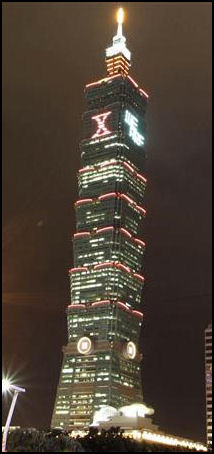
X Japan on world's highest
building in Tapei The 10th Fuji Rock Festival in 2006 began with a typhoon. The line up in that year included Red Hot Chili Peppers, Franz Ferdinand, The Strokes, Sonic Youth, Madness, The Hives, the Yeah Yeah Yeahs, and Super Furry Animals. The 2007 Fuji Rock featured The Cure, Chemical Brother, Iggy Pop and the Beastie Boys. That year fans surged the main stage after Iggy Pop invited them to join him. So many fans surged forward even Iggy pleaded with them to “go easy” and concert officials threatened to stop the show stop unless people left the stage. Iggy invited fans to rush the stage in 1998 and 2003 but didn’t cause the mayhem they did in 2007. Artists featured in 2008 including Underworld, Grandmaster Flash, Bloc Party, Feeder, Primal Scream, Bootsy Collins, Travis, Tricky, A One day ¥16,800. Three days ¥39,800.
The 2011 Fuji Festival was held in spite of the ongoing recovery from March earthquake and tsunami. Among the 214 artists that performed were Coldplay, the Arctic Monkeys, Kaiser Chiefs, Lee Scrtach Perry, Yellow Magic Orchestra and Shonen Knife. Three-day tickets were $540.
Summer Sonic is another music festival held in early August, at stadiums and arenas in Osaka and the Tokyo area. Performers have included Radiohead, Blur, Blondie, Offspring, No Doubt, Morrissey, Siouxsie and the Banshees, the Arctic Monkeys, Tool, Linkin Park, Massive Attack, Octeau Twins, My Chemical Romance, The Doors, Marilyn Manson, James Brown, Travis, and Devo.
Artists featured in 2007 included Gwen Stefan, Avril Lavigne, Black Eyes Peas, Cyndi Lauper, The Stranglers, Motorhead, Arctic Monkeys, Kasabian, Manic Street Preachers, Dinosaur Jr., and Bloc Party. Artists featured in 2008 included the Verve, Prodigy, Sex Pistols, Coldplay, Alicia Keys, Jesus and The Mary Chain. Paul Weller, Devo, Fatboy Slim. One day ¥15,000, two day ¥24,000
Other summer festivals include Rock in Japan in early August neat Tokyo in Hitachinaka, Ibaraki Prefecture and the Rising Sun Rock Festival in Ishikari, Hokkaido in late August which features almost exclusively Japanese acts like Bump of Chicken, Guitar Wolf, Cornelius, Orange Range, Dragon Ash, Asian Kung Fu Generation, Tokyo Ska Paradise Orchestra, and Soul & Pimp Sessions.
Japanese Summer Rocks Festivals 2012
The Stone Roses were the top bill at the Fuji Rock Festival at the Naeba Ski Resort in Niigata Prefecture in 2012 .More than 200 bands from Japan and abroad will performed there, including Noel Gallagher's High Flying Birds, Beady Eye, Radiohead and James Blake. [Source: Yomiuri Shimbun, July 13, 2012]
“Summer Sonic, another large summer festival in Japan, held in August in Chiba and Osaka, featured Green Day, Rihanna, New Order and Tears for Fears. Familiar Japanese artists who are popular in TV programs, such as Kyary Pamyu Pamyu and Perfume also appeared in Summer Sonic.
“Other festivals included Join Alive (Iwamizawa Park in Hokkaido), Rock in Japan Fes. (Hitachi Seaside Park in Hitachinaka, Ibaraki Prefecture), the Rising Sun Rock Festival (Ishikari Bay New Port in Otaru, Hokkaido) and Summer Sonic. Princess Princess, which reunited for the first time in 16 years to perform only for this year, was a big draw. They performed at Higher Ground (Uminonakamichi Seaside Park in Fukuoka), Rock in Japan Fes., the Rising Sun Rock Festival and Summer Sonic (in Osaka).
Popular Japanese Artists at Foreign Manga and Anime Festivals
J-Pop, visual-kei rock bands and the group X-Japan are among the biggest crowd favorites at the Japan Expo anime and manga event in Paris. A sold-out audience, some reduced to tears, watched X-Japan’s Yoshiki and Toshi do an acoustic performance. Fans of the girlie pop group Morning Musume, many of them men paid $40 each to watch them sing.
Puffy, Vamps — a new band featuring L'Arc-en-Ciel's Hyde — and Kanon of visual-kei sensations An Cafe appeared at the event in New York. In Sao Paulo the Harajuku Lovers, is a group of Brazilian girls who can sing all of Morning Musume’s hits and do the choreographed dancing that goes with them.
An Café is one of the more popular Japanese bands abroad. A visual-kei band, they are favorite at anime and manga festivals in places like Sao Paulo, Paris and Baltimore. The success has been attributed to their packaging of kawaii into “Harijuki Dance Rock.”
Miyavi is a rock guitarist that is far more popular outside of Japan than in it. He has played before large crowds in Los Angeles, where a woman once waited 19 hours to buy a ticket for his concert, and in the words of Japanese cultural diplomat Takamasa Sakirai drove “15,000 young French Japanophiles....into a frenzy” at a show in Paris.
L'Arc-en-Ciel and Cashing in on the Global Anime Market
L'Arc~en~Ciel have been around for more than 20 years. Im Japan they perform at sold-out two shows, with 40,000 seats all going at 9,000 yen a pop. On one of their shows in Osaka Roland Kelts wrote in the Daily Yomiuri,”The events were expertly paced and ludicrously high-tech--what you'd expect from a Japanese production that mixes carefully planned moments of seeming candor with expert efficiency. [Source: Roland Kelts, Daily Yomiuri, December 23, 2011]
On L'Arc~en~Ciel’s increasing popularity abroad, the band's manager Masahiro Oishi told Kelts, “In the beginning, L'Arc's music was associated with anime. But through experiencing the band's music directly, fans in several countries gradually came to recognize the band's worth based on its music alone. They have become genuine fans of L'Arc's music, whether or not they like anime."
L'Arc saw an opportunity in 2004 and had themselves booked at Otakon, the largest anime convention on the East Coast, for a live show at Baltimore's 1st Mariner Arena. The venue's 12,000 seats sold out fast. Enthusiasm for the pairing of Japanese rock and anime was infectious. "Nobody had tried anything like this [in the United States] before, certainly not on that scale," Otakon director Jim Vowles said. "But the announcement triggered a weeklong wave of Internet buzz, including buzz in Japan. And the show itself was fantastic and over-the-top, a real once-in-a-lifetime event. The reaction was overwhelmingly positive. People are still talking about that gig, almost a decade later."
L'Arc released two singles this fall and winter, the hard-driving "Chase" and the infectious "X X X (Kiss Kiss Kiss)," and they are currently finishing a new studio album. Next year, they will embark on their first world tour, with stops in Europe, the United States and Asia.Their song "Good Luck My Way" is featured on the soundtrack of the latest Fullmetal Alchemist anime film, screening across the United States in January. "We don't make any distinction between our otaku fans and our rock fans," hyde tells me. "We want them both, and we want to make them happy. I love Evangelion, for example. But I also love Depeche Mode and Duran Duran."
Kanon Wakeshima

Kanon Wakeshima is a a singer/cellist and Gothic Lolita fashion icon. Stephen Taylor wrote in the Daily Yomiuri, “Wakeshima's fusion of music genres might not appeal to everyone, yet the results are surprisingly effective, with the shrill cry of J-pop complemented by her subtle cello accompaniment. Wakeshima's debut album, “ Shinshoku Dolce “ , came out in 2009, with “ Shojo Jikake no Libretto: Lolitawork Libretto “ released the following year. [Source: Stephen Taylor, Daily Yomiuri, September 16, 2011]
Wakeshima was born in Tokyo in 1988. She has developed a musical style that combines her love of pop tunes with a passion for classical music, the latter a calling that grabbed her from an early age."I started playing the cello when I was 3," Wakeshima said, adding that her bow-wielding future had been determined when she was a mere twinkle in her parents' eyes."My mother and father are big music fans and, even before I was born, they'd decided that if they had a girl, they'd like her to play the cello, because that would be quite cool for a girl," she said.
In primary school, Wakeshima's focus was on classical music, but as her teenage years approached, she was introduced to exciting new sounds. "When I was at middle school, I discovered J-pop and thought, 'Well, what would happen if I applied my musical interpretation to J-pop?' And that's how I've gotten to where I am today," she recalled, adding that at about the same time she also found her look. "I really liked Lolita fashion when I was in middle school, but I didn't have any money so I couldn't buy the clothes. So, when I started high school and got a part-time job, I could save some money and start buying some clothes."
Wakeshima plays a different colored cellos, each with a different name. "The red cello that I used today is called Nanachie...Each of the cellos' names represent numbers in kanji. The brown one that I've been playing since I was at middle school, which I use for recording and rehearsals, is called Yaehauru, while the other ones--the white and the silver ones that are used for live performances and promotional appearances--are named Mikazuki and Momotose, respectively."
Kyary Pamyu Pamyu
Jin Kiyokawa wrote in the Yomiuri Shimbun: Kyary Pamyu Pamyu is a Harajuku fashion icon with a tongue-twister name. She made her debut as a singer in 2011 with a mini-album produced by Yasutaka Nakata, who also produced popular techno pop girl group Perfume. The promotional video for her song "PONPONPON," which is included on the mini-album, has over 17 million views on YouTube. [Source: Jin Kiyokawa, Yomiuri Shimbun, March 2, 2012]
Many overseas fans of the promotional videos have left complimentary comments in English on the website, such as "So cute!" and "I'm obsessed!" Experts point out the video's unique imagery, with floating eyeballs and animated human hearts, was startling to fans. About 6,000 fans attended her concert in Los Angeles in December. Amazed, the pop star recalled, "From the first verse starting with 'Ano Kosatende' (at the intersection), many fans sang the Japanese lyrics to 'PONPONPON' accurately. They even knew and imitated my dance to the song." The promotional video for her single "Tsukematsukeru" has already gotten over nine million views on YouTube this year.
According to Kyary Pamyu Pamyu, the theme for 2012 is "Let's enjoy Japan more," and aims to blend Japanese tradition with current fashion trends. "The trends and designs from the old days are very fashionable. People wore kimono every day and chonmage (topknot) is a novel style. There are many kinds of kanzashi hair sticks and I think these designs can be applied to current fashion," she said.
Minori Chihara
“Minori Chihara is very popular at manga and anime festivals in Europe and the United States. She first came to light in 2006 as a voice actor for one of the characters in the anime series “ The Melancholy of Haruhi Suzumiya “. Since then, she gained popularity as a singer and is now regularly featured in hit charts. The sci-fi anime, which revolves around a female high school student, became popular overseas as it distinctively depicts "Japanese-style anime" in its character designs and storyline. This style is recognized by overseas fans. [Source: Takamasa Sakurai, Daily Yomiuri, May 11, 2012]
“Describing a performance by Chihara in the New York Anime Festival at the Jacob K. Javits Convention Center in October 2010, Takamasa Sakurai wrote in the Yomiuri Shimbun: “Chihara's performance in New York was astonishing because the mostly American audience went crazy over and was touched by her songs, which were sung in Japanese. This showed there was no language barrier, despite language being long seen as an obstacle to expanding Japan's entertainment industry overseas.
“My first overseas show was at the Anime Expo in Los Angeles in 2007," Chihara said. 'Can I convey the feeling [of my lyrics] to Americans if I sing in Japanese?' Before the show, everything was unknown. I had no idea how the audience would welcome me. But they were surprisingly warm and they accepted me, so I was really happy. That's when I wondered, 'What is the importance of language?'" she said.
Image Sources: Japan Zone and Wiki Commons
Text Sources: New York Times, Washington Post, Los Angeles Times, Daily Yomiuri, Times of London, Japan National Tourist Organization (JNTO), National Geographic, The New Yorker, Time, Newsweek, Reuters, AP, Lonely Planet Guides, Compton’s Encyclopedia and various books and other publications.
Last updated August January 2013
